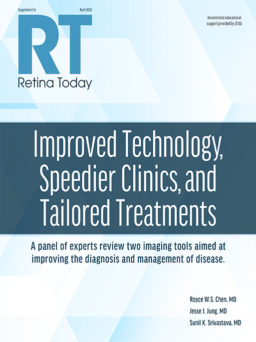In conclusion, retinopathy of prematurity (ROP) is one of the most common causes of avoidable blindness in children,1 causing irreversible visual impairment in over 32,000 infants worldwide each year.4 “Prevention is at the core of neonatal intensive care,” said Prof. Stahl. “Careful management of supplemental oxygen therapy, screening, and timely referrals are key clinical considerations.5”
In the RAINBOW study, a treatment success rate of 80% was achieved with ranibizumab 0.2 mg compared with 66% with laser, and ranibizumab 0.2 mg was well tolerated in patients with ROP.36 RAINBOW is the first study to report pharmacokinetics and systemic VEGF data in ROP. The results of its 5-year extension study are expected by 2022.36 Based on the results of RAINBOW, ranibizumab is now the first anti-VEGF therapy to be approved for the treatment of ROP.
View the full webcast, including live Q&A session, at this address bit.ly/ROPwebinar1
References
1. Solebo AL, Teoh L, Rahi J. Epidemiology of blindness in children. Arch Dis Child. 2017;102:853-857.
2. World Health Organization. Preterm birth. 2016. Available at: http://www.who.int/mediacentre/factsheets/fs363/en/. Accessed Feb 19, 2020.
3. Ludwig CA, Chen TA, Hernandez-Boussard T, et al. The epidemiology of retinopathy of prematurity in the United States. Ophthalmic Surg Lasers Imaging Retina. 2017;48:553-562.
4. Blencowe H, Lawn JE, Vazquez T, et al. Preterm-associated visual impairment and estimates of retinopathy of prematurity at regional and global levels for 2010. Pediatr Res. 2013;74 Suppl 1:35-49.
5. Hellstrom A, Smith LE, Dammann O. Retinopathy of prematurity. Lancet. 2013;382:1445-1457.
6. Heidar K. Retinopathy of prematurity. Available at: https://eyewiki.aao.org/Retinopathy_of_Prematurity#Aggressive_Posterior_ROP_.28AP-ROP.29. Accessed Feb 19, 2020.
7. Hauspurg AK, Allred EN, Vanderveen DK, et al. Blood gases and retinopathy of prematurity: the ELGAN Study. Neonatology. 2011;99:104-111.
8. Kaneshiro NK. Gestational age. Available at: https://medlineplus.gov/ency/article/002367.htm. Accessed Feb 19, 2020.
9. Mayo Clinic. Premature birth. Available at: https://www.mayoclinic.org/diseases-conditions/premature-birth/symptoms-causes/syc-20376730. Accessed Feb 19, 2020.
10. Dammann O, Leviton A, Gappa M, Dammann CE. Lung and brain damage in preterm newborns, and their association with gestational age, prematurity subgroup, infection/inflammation and long term outcome. BJOG. 2005;112 Suppl 1:4-9.
11. American Pregnancy Organisation. Premature Birth Complications. Available at: https://americanpregnancy.org/labor-and-birth/premature-birth-complications/. Accessed Feb 19, 2020.
12. World Health Organization. Born too soon: the global action report on preterm birth. 2012. Available at: https://www.who.int/pmnch/media/news/2012/201204_borntoosoon-report.pdf. Accessed April 7, 2020.
13. Costeloe K, Hennessy E, Gibson AT, et al. The EPICure study: outcomes to discharge from hospital for infants born at the threshold of viability. Pediatrics. 2000;106:659-671.
14. Costeloe KL, Hennessy EM, Haider S, et al. Short term outcomes after extreme preterm birth in England: comparison of two birth cohorts in 1995 and 2006 (the EPICure studies). BMJ. 2012;345:e7976.
15. MBRRACE-UK. Supplementary report on survival up to oneyear of ageforbabies born before 27 weeks gestational age. Available at: https://www.npeu.ox.ac.uk/downloads/files/mbrrace-uk/reports/MBRRACE-UK%20supplementary%20tables%20on%20births%20before%2027%20weeks%20gestation%202016.pdf. Accessed Feb 19, 2020.
16. Moore T, Hennessy EM, Myles J, et al. Neurological and developmental outcome in extremely preterm children born in England in 1995 and 2006: the EPICure studies. BMJ. 2012;345:e7961.
17. MacKay DF, Smith GC, Dobbie R, Pell JP. Gestational age at delivery and special educational need: retrospective cohort study of 407,503 schoolchildren. PLoS Med. 2010;7:e1000289.
18. World Health Organization. WHO recommendations on interventions to improve preterm birth outcomes. 2015. Available at: https://www.who.int/entity/reproductivehealth/publications/maternal_perinatal_health/preterm-birth-guideline/en/index.html. Accessed April 7, 2020.
19. Askie LM, Darlow BA, Finer N, et al. Association between oxygen saturation targeting and death or disability in extremely preterm infants in the neonatal oxygenation prospective meta-analysis collaboration. JAMA. 2018;319:2190-2201.
20. Royal College of Ophthalmologists. Guidelines for the screening and treatment of retinopathy of prematurity. 2008. Available at: https://www.rcophth.ac.uk/wp-content/uploads/2014/12/2008-SCI-021-Guidelines-Retinopathy-of-Prematurity.pdf. Accessed Feb 19, 2020.
21. Hakeem AH, Mohamed GB, Othman MF. Retinopathy of prematurity: a study of prevalence and risk factors. Middle East Afr J Ophthalmol. 2012;19:289-294.
22. Chan-Ling T, Gole GA, Quinn GE, et al. Pathophysiology, screening and treatment of ROP: A multi-disciplinary perspective. Prog Retin Eye Res. 2018;62:77-119.
23. Romo-Aguas JC, Gonzalez HLA, Meraz-Gutierrez MP, Martinez-Castellanos MA. Retinopathy of prematurity: incidence report of outliers based on international screening guidelines. Int J Retina Vitreous. 2019;5:53.
24. Chen J, Smith LE. Retinopathy of prematurity. Angiogenesis. 2007;10:133-140.
25. An international classification of retinopathy of prematurity. Prepared by an international committee. Br J Ophthalmol. 1984;68:690-697.
26. Bashour M. Retinopathy of Prematurity Ophthalmologic Approach. 2018. Available at: https://emedicine.medscape.com/article/1225022-overview#showall. Accessed Feb 19, 2020.
27. Molinari A, Weaver D, Jalali S. Classifying retinopathy of prematurity. Community Eye Health. 2017;30:55-56.
28. Mintz-Hittner HA, Kennedy KA, Chuang AZ. Efficacy of intravitreal bevacizumab for stage 3+ retinopathy of prematurity. N Engl J Med. 2011;364:603-615.
29. Jefferies AL. Retinopathy of prematurity: an update on screening and management. Paediatr Child Health. 2016;21:101-108.
30. National Eye Institute. Retinopathy of prematurity. 2019. Available at: https://www.nei.nih.gov/learn-about-eye-health/eye-conditions-and-diseases/retinopathy-prematurity. Accessed April 7, 2020.
31. Avery RL. Bevacizumab (Avastin) for retinopathy of prematurity: wrong dose, wrong drug, or both? J AAPOS. 2012;16:2-4.
32. Sato T, Wada K, Arahori H, et al. Serum concentrations of bevacizumab (avastin) and vascular endothelial growth factor in infants with retinopathy of prematurity. Am J Ophthalmol. 2012;153:327-33 e1.
33. Walz JM, Bemme S, Pielen A, et al. The German ROP Registry: data from 90 infants treated for retinopathy of prematurity. Acta Ophthalmol. 2016;94:e744-e752.
34. Walz JM, Bemme S, Reichl S, et al. [Treated cases of retinopathy of prematurity in Germany : 5-year data from the Retina.net ROP registry]. Ophthalmologe. 2018;115:476-488.
35. Stahl A, Krohne TU, Eter N, et al. Comparing alternative ranibizumab dosages for safety and efficacy in retinopathy of prematurity: a randomized clinical trial. JAMA Pediatr. 2018;172:278-286.
36. Stahl A, Lepore D, Fielder A, et al. Ranibizumab versus laser therapy for the treatment of very low birthweight infants with retinopathy of prematurity (RAINBOW): an open-label randomised controlled trial. Lancet. 2019;394:1551-1559.
37. Novartis Pharma AG. Lucentis summary of product characteristics. January 2020. Available at: https://www.ema.europa.eu/documents/product-information/lucentis-epar-product-information_en.pdf. Accessed April 7, 2020.
165093
